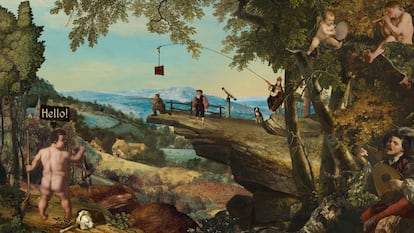The delirium of playing inside a Rembrandt painting with the humor of Monty Python
Joe Richardson culminates a very peculiar trilogy of video games with a point-and-click creation where each screen features a masterpiece of art, symphonies by Mozart or Vivaldi and a deliberately absurd plot

Human beings are peculiar creatures. There is no animal on Earth that moves so quickly and so often between the sublime and the pathetic. They can paint moving pictures and compose quasi-divine symphonies. But they can also utter atrocious insults, hurt others or pick their noses. Rembrandt, Botticelli and Mozart belong to a species that also breeds exploiters, murderers and imbeciles. Sometimes, genius and trash even coincide in the same individual. So another human being, Joe Richardson, had a strange idea: to put all of this together in a video game.
Each screen in Death of the Reprobate is a masterpiece of Renaissance, Romantic or Rococo painting, set in motion by the English creator. Famous melodies by Beethoven and Vivaldi can be heard in the background. Against this lofty backdrop, however, the developer places a series of infamous characters, each one more ridiculous, pitiful or despicable than the last. And he builds a narrative delirium in which he acknowledges the influence of Monty Python. This entire world, or almost, was created by him alone. Perhaps the most absurd thing of all is that the formula works — so much so that this latest game closes a trilogy that began with Four Last Things and continued with The Procession to Calvary — and has earned Richardson good reviews, sales and public reaction. One in particular has amazed him — the feedback from art or history professors and researchers: “I’ve had a few. And they are always surprisingly positive!”
Nothing pleasant, however, seems to inhabit the protagonist’s soul. At the start of the game, Malcolm the Shit visits his father, Immortal John. The father’s nickname is a misrepresentation: he is on his deathbed. The son, on the other hand, is true to his moniker: he is not at all interested in the old man’s health, and only seems concerned with inheriting the throne. To obtain it, however, the father demands that his son change his life and perform seven good deeds. From there, the player must lead Malcolm the Shit on a journey to solve the improbable needs of the town’s inhabitants. It involves talking, collecting objects and solving puzzles, a genre known as a point-and-click graphic adventure. But, above all, it involves watching how paintings by Bruegel the Elder or James Seymour come to life, enjoying piano and violin music, and laughing at the increasingly surreal dialogues and situations. On condition, of course, that you are able to appreciate a very non-politically correct humor, which some users will love but others may find too scatological, macabre or vulgar.
We can summarize the game with one of the first interactions: a man wants to fish, but he can’t do so while two other locals are busy throwing rocks into the water. When Malcolm tries to convince them to stop, they deliver a long and heartfelt anti-capitalist manifesto to explain that they’ve left everything behind with the sole aim of doing whatever they want in life. And they have discovered that what fulfills them the most is precisely throwing stones into the water. Later, in the village art gallery, the protagonist discovers the same two people depicted in one of the paintings. When he persuades a trio of monkeys to modify the canvas, it turns out that reality changes too. And so the fisherman can finally fulfil his wish. One less good deed on the list. And so on.

“I certainly can’t deny that the art, music and (arguably Pythonesque) humour are the key elements that make the game what it is. But I think one of my main strengths in making these games is to ensure these elements are all carefully intertwined. So I would prefer to call it a ‘tapestry’ of these elements, rather than a mixture. Everything is intertwined,” adds Richardson. The setting itself sometimes contributes to solving a puzzle: Malcolm can join a dance or a musical show; the conversations address the Renaissance with irony, but without giving up on contemporary political satire. Although the author is clear about the fact that “the driving force for everything is always the art. The story is led by the art, not the other way around. I make all the artwork first, background animations, sometimes even get as far as building the rooms in editor so I can walk around the whole empty world, trying to figure out what will go on there. And the writing process becomes like a puzzle for me to solve, fitting the existing elements together in a way that (largely) makes sense.”
Richardson explains that he spends a lot of time looking at paintings on museum websites, galleries or Wikipedia. He is looking for scenes for his video games, but above all, for pure personal pleasure: “I would not be able to treat these games with the love and care that I have if I didn’t also love the art.” Years ago, he was bouncing between animation, music, illustration and writing, until he realized that video games would allow him to bring it all together. So he also learned to program. The only thing that kept him from doing so was one eternal problem: “I don’t know how to draw.”
That’s why, in 2016, for his first video game, The Preposterous Awesomeness of Everything, he used photo montages. But in hindsight, he believes that decision alienated part of the public. So the spark for his painting trilogy is not due to any “big idea,” according to Richardson: “The ‘big idea’ so to speak was simply ‘what if I do the same thing again. But using more attractive source material’. And the most attractive source material I could think of was Renaissance art.” The public domain gave him thousands of wonderful works to tweak. And his talent allowed him to make two video games on his own. For Death of the Reprobate, for the first time, he has collaborated with a musician, Eduardo Antonello.
But Richardson also seeks answers in his works to a society that he doesn’t quite understand: “The overwhelming chaotic disgusting beautiful unfathomable mess of the real world scares the shit out of me. For me, making games is an escape. But it isn’t a cure! In fact, while I am hiding in my safe space I am actively avoiding the search for a cure and instead allowing myself to fall deeper and deeper into the hole of existential despair. Each time I peek out from my cave the ‘everything’ seems bigger and more frightening. So I retreat. I am good at making games, but I am terrible at living.” He says that growing up has calmed his instinct to always be moving on to something else. “But I’m not ready to settle into comfortable mediocrity just yet! So it’s time to kick myself up the arse and learn something new.” So no more graphic adventures and no more Renaissance art. Richardson promises that his next work will be different. Better? Worse? We’ll see: human beings are capable of anything.
Sign up for our weekly newsletter to get more English-language news coverage from EL PAÍS USA Edition
Tu suscripción se está usando en otro dispositivo
¿Quieres añadir otro usuario a tu suscripción?
Si continúas leyendo en este dispositivo, no se podrá leer en el otro.
FlechaTu suscripción se está usando en otro dispositivo y solo puedes acceder a EL PAÍS desde un dispositivo a la vez.
Si quieres compartir tu cuenta, cambia tu suscripción a la modalidad Premium, así podrás añadir otro usuario. Cada uno accederá con su propia cuenta de email, lo que os permitirá personalizar vuestra experiencia en EL PAÍS.
¿Tienes una suscripción de empresa? Accede aquí para contratar más cuentas.
En el caso de no saber quién está usando tu cuenta, te recomendamos cambiar tu contraseña aquí.
Si decides continuar compartiendo tu cuenta, este mensaje se mostrará en tu dispositivo y en el de la otra persona que está usando tu cuenta de forma indefinida, afectando a tu experiencia de lectura. Puedes consultar aquí los términos y condiciones de la suscripción digital.
More information
Archived In
Últimas noticias
Chris Martin, Taylor Swift, Elijah Wood and other famous wedding ‘crashers’
‘How does it feel to be a failure?’: Elizabeth Berkley’s journey from ‘Showgirls’ ridicule to vindication
The story of the Málaga virus: The code that haunted Google’s cybersecurity center director for 30 years
The impact of Ecuador’s mega-prison: A polluted river, cleared forests and military checkpoints
Most viewed
- Christian Louboutin: ‘Young people don’t want to be like their parents. And if their parents wear sneakers, they’re going to look for something else’
- The low-cost creative revolution: How technology is making art accessible to everyone
- All the effects of gentrification in one corner of Mexico’s Colonia Roma
- Liset Menéndez de la Prida, neuroscientist: ‘It’s not normal to constantly seek pleasure; it’s important to be bored, to be calm’
- December Social Security and SSI payments: Dates, double checks and the 2026 COLA increase











































